 W
WAbacarus hystrix, the cereal rust mite or grain rust mite, belongs to the family Eriophyidae. They are extremely small with adults measuring up to 1 millimetre in length and only have four legs at the front of the body. Viewing by the human eye requires a 10 – 20X lens. The adult mites are usually yellow but also have been seen to be white or orange. The cereal rust mite was first found on Elymus repens, a very common perennial grass species. It has now been found on more than 60 grass species including oats, barley, wheat and ryegrass, found in Europe, North America, South Africa and Australia. Mites migrate primarily through wind movement and are usually found on the highest basal sections of the top two leaf blades. Abacarus hystrix produces up to twenty overlapping generations per year in South Australian perennial pastures, indicating that the species breeds quite rapidly. It has been noted that the cereal rust mite can cause losses in yield of up to 30-70%.
 W
WAbacarus sacchari, the sugarcane rust mite, is an agricultural pest mite mostly on sugar cane plantations in Africa, Brazil, India, Guatemala, Costa Rica and Venezuela.
 W
WAcarapis woodi is an internal parasite affecting honey bees, the symptoms of infestation was originally observed on the Isle of Wight in 1904, but was not described until 1921. Acarapis woodi mites live and reproduce in the tracheae of the bees. The symptoms of Acarapis woodi infestation were originally called by beekeepers as the Isle of Wight Disease, however it is now called Acarine, after the Subclass to which the mites belong. All mites are arachnids like spiders. The female mite attaches 5–7 eggs to the tracheal walls, where the larvae hatch and develop in 11–15 days to adult mites. The mites parasitize young bees up to two weeks old through the tracheal tube openings. There, they pierce the tracheal tube walls with their mouthparts and feed on the haemolymph of the bees. More than a hundred mites can populate the tracheae and weaken the bees. The mites are generally less than 175 micrometres (0.007 in) long, and can only be seen and identified under a microscope.
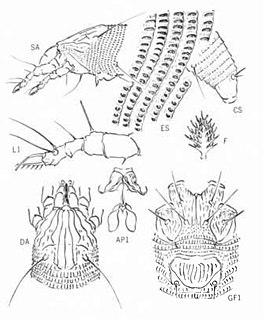 W
WAceria guerreronis, the coconut mite, is an eriophyid mite which infests coconut plantations. It is economically devastating, and can destroy up to 60% of coconut production. The immature nuts are infested and injured by mites feeding in the portion covered by the perianth of the immature nut.
 W
WAceria tosichella, commonly known as the wheat curl mite (WCM), is a global cereal pest and a vector for spreading and transmission of viruses like wheat streak mosaic virus (WSMV) and wheat mosaic virus (WMoV)
 W
WBrevipalpus phoenicis, also known as the false spider mite, red and black flat mite, and in Australia as the passionvine mite, is a species of mite in the family Tenuipalpidae. This species occurs globally, and is a serious pest to such crops as citrus, tea, papaya, guava and coffee, and can heavily damage numerous other crops. They are unique in having haploid females, a condition caused by a bacterium that change haploid males into females.
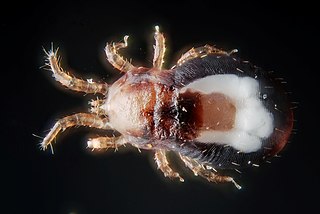 W
WDermanyssus gallinae is a haematophagous ectoparasite of poultry. It has been implicated as a vector of several major pathogenic diseases. Despite its common names, it has a wide range of hosts including several species of wild birds and mammals, including humans. In both size and appearance, it resembles the northern fowl mite, Ornithonyssus sylviarum.
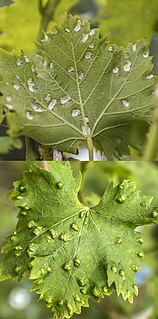 W
WEriophyes vitis is a mite species in the genus Eriophyes infecting grape leaves.
 W
WEriophyidae is a family of more than 200 genera of mites, which live as plant parasites, commonly causing galls or other damage to the plant tissues and hence known as gall mites. About 3,600 species have been described, but this is probably less than 10% of the actual number existing in this poorly researched family. They are microscopic mites and are yellow to pinkish white to purplish in color. The mites are worm like, and have only two pairs of legs. Their primary method of population spread is by wind. They affect a wide range of plants, and several are major pest species causing substantial economic damage to crops. Some species, however, are used as biological agents to control weeds and invasive plant species.
 W
WThe flour mite, Acarus siro, a pest of stored grains and animal feedstuffs, is one of many species of grain and flour mites. An older name for the species is Tyroglyphus farinae.
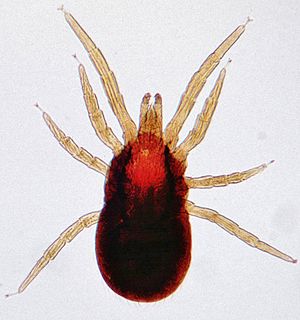 W
WMites are small crawling animals related to ticks and spiders. Most mites are free-living and harmless. Other mites are parasitic, and those that infest livestock animals cause many diseases that are widespread, reduce production and profit for farmers, and are expensive to control.
 W
WOligonychus pratensis, the Banks grass mite, is a species of mite in the spider mite family. They are considered a pest and often infest corn and turf grasses.
 W
WOrnithonyssus sylviarum is a haematophagous ectoparasite of poultry. In both size and appearance, it resembles the red mite, Dermanyssus gallinae.
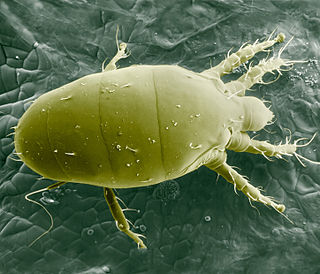 W
WThe broad mite, Polyphagotarsonemus latus, is a microscopic species of mite found on many species of plants, including important agricultural species such as grapes, apples, and other fruits. Broad mites are also currently affecting cannabis plants, as the industry matures with legalization. The mites are found in many areas throughout the world and are major pests in greenhouses.
 W
WSteneotarsonemus spinki, the panicle rice mite, spinki mite, or rice tarsonemid mite, is a species of mite in the family Tarsonemidae, the white mites. It is a serious pest of rice in tropical Asia, Central America, and the Caribbean.
 W
WTetranychus urticae is a species of plant-feeding mite generally considered to be a pest. It is the most widely known member of the family Tetranychidae or spider mites. Its genome was fully sequenced in 2011, and was the first genome sequence from any chelicerate.
 W
WThe peacock mites of the genus Tuckerella are a significant herbivorous pest in the tropics, for example on citrus fruit. Other species dwell in grasses, possibly as root feeders.
 W
WVarroa destructor is an external parasitic mite that attacks and feeds on the honey bees Apis cerana and Apis mellifera. The disease caused by the mites is called varroosis.
 W
WVarroa jacobsoni is a species of mite that parasitises Apis cerana. The more damaging Varroa destructor was previously included under the name V. jacobsoni, but the two species can be separated on the basis of the DNA sequence of the cytochrome oxidase I gene in the mitochondrial DNA.